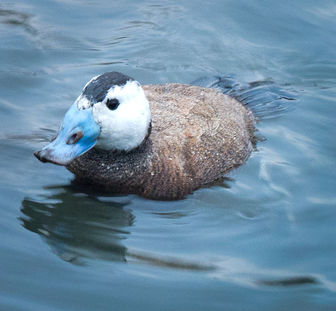White-headed Duck
Adult males have a grey and reddish body, a blue bill and a largely white head with a black cap and neck. Adult females have a grey-brown body with a white face and a darker bill, cap and a cheek stripe.

Original source: Own work
Author: MissTanyaLove
Permission: GNU Free Documentation License
The White-headed Duck is classified as Endangered (EN), considered to be facing a very high risk of extinction in the wild.
The White-headed Duck (Oxyura leucocephala) is a small stiff-tailed duck. Adult males have a grey and reddish body, a blue bill and a largely white head with a black cap and neck. Adult females have a grey-brown body with a white face and a darker bill, cap and a cheek stripe. This duck breeds in Spain and North Africa, with a larger population in western and central Asia. More
The white-headed duck is one of Europe’s rarest birds (4). The name of the genus ‘Oxyura’, means pointed tail, while leucocephala means white-headed. It is actually the males that have a white head, with a black cap. They also have a distinctive blue bill which is swollen at the base (2). Females have a pale face with a cheek-stripe, a dark cap, and a blackish, less swollen bill. Both males and females are chestnut-brown, with short, black webbed feet. More
The white-headed duck has a wide range and occurs in Spain, Algeria, Tunisia, Russia, Kazakhstan, Turkey, Iran, Afghanistan, Uzbekistan, Pakistan and Mongolia. Its status in China is unclear. It is found on passage in winter months in the eastern Mediterranean, the Middle East, central Asia and the Indian subcontinent (2). - Inhabits wetlands that are composed of freshwater or alkaline eutrophic lakes, with plenty of vegetation (2). More
The White-headed Duck is one of the species to which the Agreement on the Conservation of African-Eurasian Migratory Waterbirds (AEWA) applies. References * BirdLife International (2006). Oxyura leucocephala. In: IUCN 2006. IUCN Red List of Threatened Species. Downloaded on 11 May 2006. Database entry includes justification for why this species is endangered Copyright: Wikipedia. More
White-Headed Duck determination Similar species Anatidae American Wigeon | Baikal Teal | Bar-Headed Goose | Barnacle Goose | Barrows Goldeneye | Bean Goose | Black Swan | Blue-Winged Teal | Brent Goose | Bufflehead | Cackling Goose | Canada Goose | Canvasback | Common Scoter | Egyptian Goose | Eider | Falcated Duck | More
white-headed duck is a subtle (but duller) blend of browns with a dark neck, smaller dark cap and a blue grey bill. The next part of the problem is that these two ducks are closely enough related to breed successfully, resulting in lots of little hybrid ducklings swimming about the ponds of Europe. More
For the purposes of our bird news services, White-headed Duck is classed as Common: common species, including species that are certain or probable escapees from captivity when occurring in the British Isles. (Note that rarity levels are currently applied nationally and may not reflect local variations in abundance. More
In Spain, White-headed Duck breeds in ponds of Ciudad Real, Toledo, Alicante, Almer More
Action Plan for the White-headed Duck in Europe African-Eurasian Waterbird Agreement (AEWA) International Action Plan 2006 Detailed species account from Birds in Europe: population estimates, trends and conservation status (BirdLife International 2004) Fully detailed species accounts from the Threatened birds of Asia: the BirdLife International Red Data Book (BirdLife International 2001), together with new information collated since the publication of the Red Data Book Text account compilers Jonathan Ekstrom (BirdLife International), James Gilroy More
White-headed Duck Habitat Endangered. White-headed Duck is one of the rarest bird species in the world, with a world population of no more than 15,000 birds. Its present distribution is highly scattered, having two main subpopulations, one in western and the other in eastern Mediterranean, the Black Sea and the Caspian Sea. The western population is resident, breeding mainly in Spain but also in Algeria and Tunisia. The eastern population is larger and migratory. More
Aspects of the topic white-headed duck are discussed in the following places at Britannica. Assorted References * conservation and extinction issues (in conservation (ecology): Introduced species) ...species that would not normally meet. If the resident species is extremely rare, it may be genetically swamped by the more abundant alien. More
experts in the conservation of the White-headed Duck have been held in Spain and, given the grave state of affairs, it was decided that the only possible solution was the selective elimination of the Ruddy Duck and hybrid individuals. These measures have been in force since 1990. Between 1991 and 2001 it has been estimated that about a hundred Ruddy Ducks arrived in Spain. Of the resulting population some 98 pure bred Ruddy Ducks and 58 hybrids were eliminated during the same period. More
White-headed duck is an unusual duck, easily distinguished by everyone lucky enough to observe it in a wetland. Drake has a large white head, black neck and bluish "swollen bill", while its body is light brown and its spiked stiff tail is often erected, giving it a distinct silhouette. Drakes and ducks have the same size, no more than 43-48 cm, but ducks have generally darker head, light-colored cheeks crossed by a dark line, while their body is chestnut-rufous. More
The white-headed duck numbers only 2,400 in Western Europe, and only 10,000 globally. The major threat to the white-headed duck is hybridisation with the non-native North American ruddy duck. The UK wants Europe-wide action to save the endangered birds by cutting the numbers of North American ruddy ducks in the wild. The UK, France and Spain have already taken positive action to control their ruddy duck populations. More

Original source: Blake Matheson
-Blake Matheson -Author: Blake Matheson
Permission: Some rights reserved
Family : Anatidae
Genus : Oxyura
Species : leucocephala
Authority : (Scopoli, 1769)
